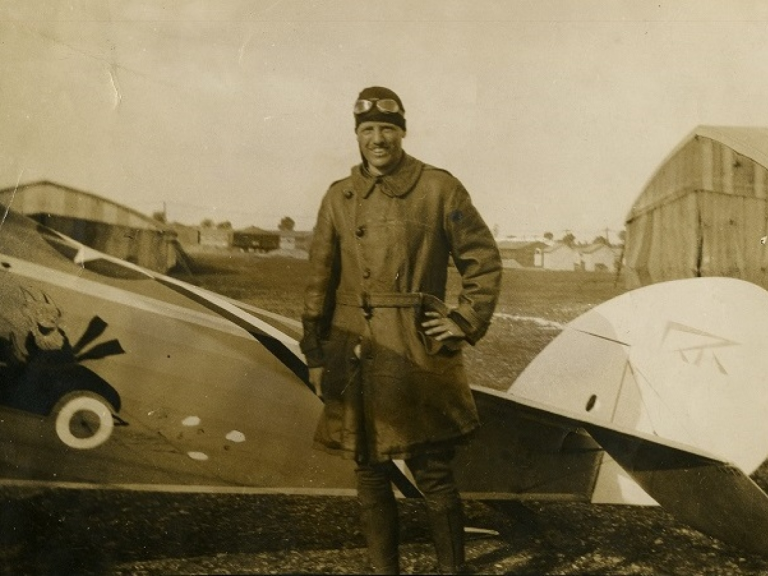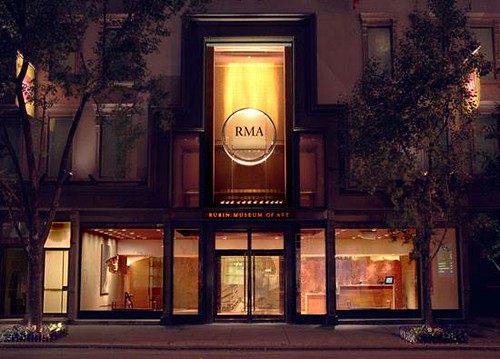
In 1939, at the height of the Sino-Japanese War, a 19-year-old Harvard art history student set off for the remote region of Lijiang, China, in search of the mysterious ancient culture of the Naxi (Nah-shee).

New York, N.Y. Launched on his quest after receiving a gift of a 40-foot Naxi funeral scroll depicting a soul’s journey through heaven and hell in a pictographic script, Quentin Roosevelt, grandson of President Theodore Roosevelt, traveled for four months before he finally reached the mountainous region on the Tibetan border.
There, with the help of the Reverend James Andrews, a family friend and Pentecostal missionary based in Lijiang, he spent ten days assembling what was to become one of the most complete collections of Naxi art outside of China.

This first-ever exhibition of the collection of Naxi art that the young Roosevelt gathered on his journey of discovery is on view at the Rubin Museum of Art. Quentin Roosevelt’s China: Ancestral Realms of the Naxi, which will remain on view through September 19, 2011, unites the Roosevelt collection with that of legendary botanist-explorer Joseph Rock, the first Western explorer to extensively study the complex religious and linguistic traditions of the Naxi, and whose collection has also never been publicly displayed.

before he finally reached the mountainous region on the Tibetan border.
Guest-curated by Cindy Ho and anthropologist Christine Mathieu, along with the Rubin Museum of Art’s former Chief Curator Martin Brauen, the exhibition includes 147 works showcasing the art central to the Naxi Dongba religion, a highly-structured tradition comprising approximately one thousand ceremonies and sub-ceremonies. Much of the art is adorned with a pictographic script that is unique to the Naxi, and possesses a freshness and spontaneity that suggests a focus on content rather than artistic labor.
Among the highlights are:
Ceremonial funeral scrolls, which are central to the Dongba religion as they act as bridges for souls to reach the realm of the gods.
One such scroll, forty feet long and a foot wide, leads a soul on the arduous journey through the gates of hell on to the realm of the gods in intricately painted scenes of the various realms of existence. Funeral scrolls are unique to the Naxi religion and are found nowhere else in China or Tibet.
Ritual cards were used in the many Dongba ceremonies. One set of cards that represents flying creatures was ritually hung above the altar. The ten brightly painted cards that each depict a wild bird, except one which shows a bat, were used in a ceremony called Sizhpiu to request longevity.
Ceremonial Manuscripts were written by Dongba priests in a pictographic script and contain the entire religion’s corpus in about one thousand ceremonial books. The pictographs represent words or syllables, and script tended to be altered as priests took on their own styles and created their own schools.

3.5 x 11 in. Harvard‐Yenching Library, Harvard University.
The exhibition will include a number of texts, including those used in divination ceremonies, funerals for those who died at a young age, and ceremonies for honoring spirits of the natural world, among others.
The dramatic story of Roosevelt’s journey is brought to life in the exhibition’s Explore Area, which features digitized photographic documentation, written correspondence, and actual artifacts from his trip, including Roosevelt’s camera and passport. This section provides a glimpse into Roosevelt’s personal experiences on his journey—what he saw and felt as he encountered the Naxi culture, religion, and art.
Residing in a remote mountainous region between Tibet and the south-western Chinese provinces of Yunnan and Sichuan, the Naxi and especially their religious art are still relatively unknown. In fact, the thesis Roosevelt wrote as an undergraduate in 1941 remains the only academic thesis on Naxi art in Western and Chinese scholarship.
“In an era before easy air travel and GPS, the young Roosevelt, inspired by the gift of an enigmatic scroll, embarked on an extraordinary journey to a remote region of war-torn China,” said Martin Brauen. “His expedition has brought exceptional artifacts to the United States and the Naxi culture to the attention of a larger public, a great and enduring contribution.”

Watercolor on hemp paper (?). 8.9 x 6 in. Collection of Dr. John M. Lundquist.
Guest curator Cindy Ho first researched and conceived of an exhibition on Naxi religious art in 1993. Ho gained access to Roosevelt’s personal journals and collections through the generous support of his family, enabling her to track down all of the works he had assembled through his explorations. She traveled to Lijiang four times, retracing his footsteps and visiting villages he and Joseph Rock had written about.
In 1997, Ho was joined by ethnohistorian Christine Mathieu, who had just received her PhD on the reconstruction of the social, religious, and political history of the Naxi. Mathieu traveled to Yunnan twice to research the details of the Roosevelt collection in consultation with Naxi priests and scholars. In 2009, sixteen years after Ho first began working on a Naxi exhibition, she and Mathieu were approached by the Rubin Museum of Art’s Chief Curator Martin Brauen about collaborating on a show about the Naxi culture.

“Roosevelt’s detailed study of the Naxi tradition, illustrated with his own diagrams and photographs, provides an invaluable window into the world of a little-known culture. His undergraduate work exhibits tremendous courage in its original interpretations and analyses,” said Ho. “In many ways, it has been a blessing that the exhibition took so many years to realize. The Rubin Museum is the perfect venue and has allowed us to expand on our original concept of exhibiting Roosevelt’s collection.”
The ancestors of the Naxi people, called Mosuo (Mo-so), settled in the Lijiang plain in Yunnan province, China in the tenth or eleventh century. Today, the Naxi are one of fifty-six national groups that form the Chinese nation. The Naxi have fascinated scholars and visitors from around the world with their complex and highly-structured religion, Dongba, and especially for the spontaneous and freeform pictographic script in which the religion is written.

Dongba artist-priests were recognized for their artistic ability and the most influential created their own styles and schools, adding to the complexity and mysteries of the tradition. Quentin Roosevelt’s China examines and explores the artistry central to the Dongba religion.
“The Rubin’s curatorial and educational programs are focused on journeys of discovery. Discovering new cultures and ideas. Discovering rare and magnificent works of art. And personal discovery for our audiences as they encounter cultures and worlds for the first time,” said Marcos Stafne, Head of Education and Visitor Experience. “The museum strives to create a window into a diverse landscape of artistic expression and to capture the shared human drive to explain the complex world around us.”
Quentin Roosevelt’s China continues the museum’s tradition of bringing to the fore previously little-known cultures and creating ground-breaking exhibitions. In 2007, the museum presented Bon: The Magic Word, the first major exhibition in the world dedicated to art of the Bon culture and belief system that predates Buddhism in Tibet.
In 2009 the museum was home to the first public display of Carl Gustav Jung’s famous Red Book, in conjunction with the first ever facsimile and translation of the original work. The exhibition on the Naxi religion exemplifies the museum’s interest in providing audiences with unprecedented experiences.

Cindy Ho reconstructed the Quentin Roosevelt collection and conceived the idea for an exhibition on the Naxi based on the collection in 1993. She identified the Naxi Dongba artifacts collected by Roosevelt, forgotten and dispersed in five different locations. Ho has lectured about the Roosevelt collection at Harvard University and New York’s China Institute. In 1997, she produced Trailing the Written Word: The Art of Writing Among China’s Ethnic Minorities and West of the East – A Journey Through Macau, Asia’s First and Last Colony in 1999, sponsored by the New York Foundation for the Arts and supported by Fundaçao Oriente. Ho lives in New York City.
Christine Mathieu is an ethnohistorian and anthropologist who has studied the histories and cultures of the Naxi and Mosuo people since 1989. She was one of the first anthropologists to work in the field of Naxi studies after the communist revolution of 1949. In 1997 she joined Cindy Ho to work on the Roosevelt exhibition. She has contributed chapters to several anthologies and authored two books on the Naxi and Mosuo, A History and Anthropological Study of the Ancient Kingdoms of the Sino-Tibetan Borderland and the internationally-acclaimed Leaving Mother Lake, with Yang Erche Namu. Mathieu lives in Melbourne, Australia.
Dr. Martin Brauen, former Chief Curator at the Rubin Museum of Art, studied Buddhism at Delhi University and anthropology and history of religions at Zurich University. Field studies have taken him to Ladakh, Nepal, Bhutan, and Tibet. Brauen joined the museum as Chief Curator in 2008 and served until July 1, 2011. He had previously been head of the Department of Tibet, Himalayas and the Far East at the Ethnographic Museum of the University of Zurich. He is the author of numerous English language publications about Tibetan and Himalayan art and culture, including The Dalai Lamas, Dreamworld Tibet, and Deities of Tibetan Buddhism, as well as a number of publications in German.
The exhibition Quentin Roosevelt’s China: Ancestral Realms of the Naxi is accompanied by a 200-page color-catalogue edited by Christine Mathieu and Cindy Ho that offers a comprehensive introduction to Naxi art, iconography, and religion and will be the first publication of its kind.
The contributions include introductions by Mathieu and Ho; two biographical pieces: the first on Quentin Roosevelt’s journey to China by Chief Curator Martin Brauen, and the second on the life of Joseph Rock by Rock’s late biographer Sylvia Sutton.
It also includes essays by scholars of the Naxi nationality on Naxi history, Dongba art, and women in the Dongba religion; a comparative review of Naxi and Mosuo religious traditions; an essay on Dongba language and the pictographic script; a comprehensive review of Dongba religion and its history by Mathieu; and an interview with Yang Fuquan, also a scholar of the Naxi nationality and vice-president of the Yunnan Academy of Social Sciences.
The Rubin Museum of Art holds one of the world’s most important collections of Himalayan art. Paintings, pictorial textiles, and sculpture are drawn from cultures that touch upon the arc of mountains that extends from Afghanistan in the northwest to Myanmar (Burma) in the southeast and includes Tibet, Nepal, Mongolia, and Bhutan.

The larger Himalayan cultural sphere, determined by significant cultural exchange over millennia, includes Iran, India, China, Central Asia, and Southeast Asia. The museum explores these rich cultural legacies—largely unfamiliar to Western viewers—from a variety of perspectives, offering multiple entry-points for understanding and enjoying the art of the Himalayas.
Rubin Museum: Young Explorer Quentin Roosevelt Searched Art in Wartime China (Originally published in Daily Kos, July 1, 2011)
See Stories by Jim Luce on:
Art | China | New York | Tibet
Follow Jim Luce on Facebook, Instagram, LinkedIn, TikTok, and X (Twitter).
© 2024 The Stewardship Report on Connecting Goodness – Towards Global Citizenship is published by The James Jay Dudley Luce Foundation Supporting & Educating Young Global Leaders is affiliated with Orphans International Worldwide, Raising Global Citizens. If supporting youth is important to you, subscribe to J. Luce Foundation updates here.